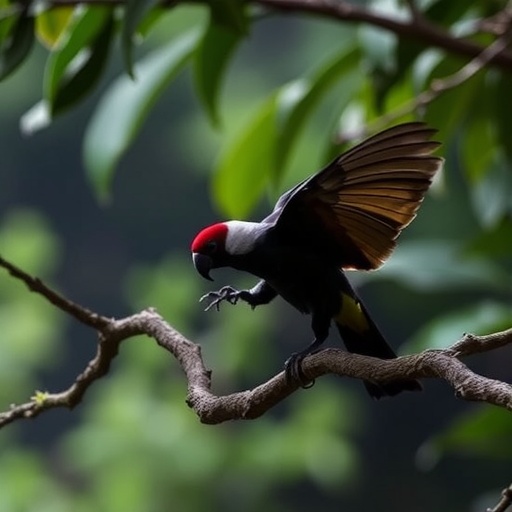In a groundbreaking advancement for biodiversity conservation, an international team of researchers, including experts from the San Diego Zoo Wildlife Alliance and the Museo de Historia Natural de la Universidad Nacional Mayor de San Marcos, has pioneered an innovative method of in situ DNA barcoding directly in the Peruvian Amazon. This remote and ecologically critical region, known for its unparalleled species richness, faces escalating threats from habitat destruction and wildfires. Accurate and immediate genetic identification is vital to preserving its diverse wildlife, yet until now, major gaps existed in global genetic databases, impeding conservation efforts.
The Peruvian Amazon’s vast and vulnerable ecosystems harbor an immense variety of species, many of which remain genetically undocumented. Studies reveal that nearly half of the region’s native birds and mammals lack representation in prominent genetic repositories such as GenBank, the Barcode of Life Database (BOLD), and Figshare. These alarming deficiencies drastically limit scientists’ capacity to monitor biodiversity dynamics or respond effectively to ecological crises. Traditional biodiversity assessment techniques, including environmental DNA sampling, rely heavily on comprehensive genetic reference data, rendering them ineffective in such data-poor contexts.
To confront this critical challenge, the research collective deployed portable nanopore sequencing technologies capable of conducting DNA barcoding within the field itself—bypassing the need to transport biological samples outside Peru. This technological leap not only enables real-time sequencing but also empowers local conservationists and scientists to generate and analyze data autonomously. By establishing three mobile laboratories within the Amazon, the team has transformed the paradigm of biodiversity documentation, facilitating immediate insight into genetic diversity right where species thrive.
This approach yielded unprecedented results between 2018 and 2023, during which researchers produced new genetic barcodes for 1,858 specimens. Included were the first-ever barcodes for 30 mammal and 196 bird species, a monumental increase in the representation of Peruvian wildlife within genetic databases, boosting mammalian coverage by 110% and birds by over 36%. Such expansive database enrichment is critical; it fortifies global bioinformatics resources and enables the more precise application of conservation genetics.
The technological backbone of this initiative is the use of long-read nanopore sequencing devices, which offer immediate data acquisition and analysis without reliance on traditional laboratory infrastructure. This portability is especially vital in biodiversity hotspots like the Amazon, where logistics often hinder comprehensive field studies. Beyond mere convenience, in situ sequencing accelerates response times to illegal wildlife trafficking and environmental disturbances, providing a robust toolset for field biologists acting as ecological guardians.
A central theme of the project highlights the importance of scientific sovereignty—the empowerment of Peruvian institutions to steward their own natural heritage autonomously. By circumventing dependencies on foreign sequencing facilities, the model fosters local expertise, strengthens institutional capacity, and promotes sustainable conservation leadership within the region. This paradigm shift ensures that data generation and interpretation remain embedded within the communities most intimately connected to these environments.
Moreover, this research underscores the precarious urgency of documenting biodiversity amidst accelerating global change. As species disappear, often without ever being genetically cataloged, conservationists must act with unprecedented speed and technological proficiency. The fusion of cutting-edge genomic tools and local scientific stewardship emerges as an essential strategy to safeguard evolutionary legacies and ecosystem integrity in biodiversity-rich countries facing resource limitations.
Beyond the Amazon, the implications of this research resonate on a global scale. The methodology pioneered here provides a scalable blueprint adaptable to other biodiversity hotspots across South America, Africa, and Southeast Asia. It offers hope for more inclusive and effective conservation programs capable of responding to biodiversity loss with genetic precision, fostering collaborative science that respects local contexts and sovereignty.
The interdisciplinary collaboration fueling this breakthrough united institutions such as the Amazon Conservation Association, Conservación Amazónica-ACCA, Field Projects International, and the Inkaterra Association. Together, these partners melded expertise in genomics, ecology, and conservation to drive innovation at the intersection of technology and environmental science. Their shared endeavor not only advanced scientific understanding but also cultivated a pathway for conservationists worldwide to harness genomic data independently.
Such transformative progress in genetic biodiversity monitoring reflects a larger shift within conservation biology toward integrating technological innovation, data democratization, and community-led research. It signals a future in which real-time genomic data informs rapid decision-making, enhances species protection, and buttresses ecosystem resilience against mounting anthropogenic threats. This initiative exemplifies how science, technology, and local empowerment converge to chart a new era in safeguarding Earth’s biological heritage.
In sum, by decoding the Peruvian Amazon’s biological complexity through in situ DNA barcoding, this pioneering research offers a potent strategy to confront biodiversity loss head-on. It bridges persistent genetic data gaps, fosters scientific autonomy, and revitalizes conservation methodologies with unprecedented agility. The success of this approach holds profound promise for preserving some of the planet’s most vital and vulnerable ecosystems well into the future.
Subject of Research: Animals
Article Title: Decoding the Peruvian Amazon with in situ DNA barcoding of vertebrate and plant taxa
News Publication Date: 1-Oct-2025
Web References: https://dx.doi.org/10.1038/s41597-025-05697-z, https://insitulabs.org/
References: Scientific Data Journal (DOI: 10.1038/s41597-025-05697-z)
Image Credits: San Diego Zoo Wildlife Alliance
Keywords: Biodiversity, Nanopore sequencing, DNA sequencing, Wildlife, Vertebrates, Plants, Biodiversity conservation, South America, Birds





